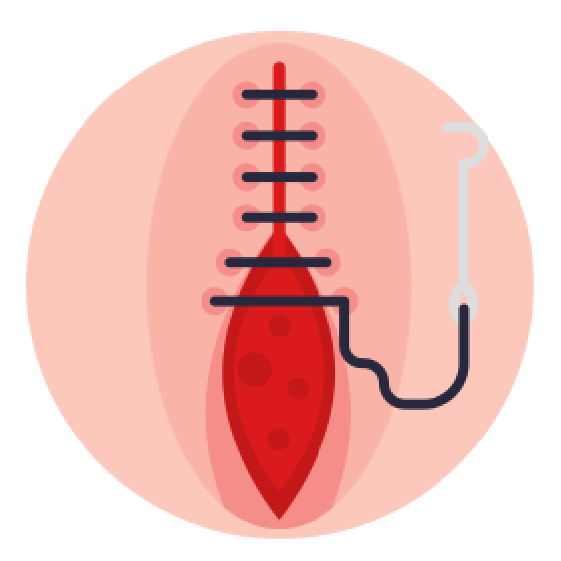Wound Care Clinic
Pressure Wound Care
Pressure wounds are pressure ulcers, also referred to as bedsores or decubitus ulcers, are a range of wounds that vary in severity and are typically caused by prolonged pressure on specific areas of the body. These ulcers are categorized into four stages based on the depth and severity of the tissue damage they cause. Stage 1 ulcers are superficial and have not yet broken through the skin. Stage 2 ulcers involve a break in the top two layers of skin. Stage 3 ulcers extend deeper, affecting the top two skin layers and fatty tissue. The most severe are Stage 4 ulcers, which are deep wounds that can impact muscles, tendons, ligaments, and even bone. Pressure ulcers often develop when an individual remains in one position, such as sitting or lying down, for extended periods, leading to restricted blood flow and damage to the tissues in the affected area. These ulcers are a significant concern in healthcare settings and require diligent preventive measures and appropriate care to manage and treat effectively.
Indications and Care
Decoding Pressure Ulcer Stages
Stage 1
- Symptoms: Redness (or blue/purple for darker skin tones), persists >30 mins after pressure release, non-blanching, warmth, hardness, minor discomfort.
- Treatment: Pressure relief, gentle cleaning, hydration, balanced nutrition, pain management, prevention measures, medical evaluation, education.
Stage 2
- Symptoms: Shallow, exposed wound, blister with clear/yellowish fluid, possible burst blister, pus, pain, swelling, tenderness, redness.
- Treatment: Pressure relief, seek medical attention, specialized wound dressings, hygiene, bandaging, monitor for infection signs.
Stage 3
- Symptoms: Cavity or depression, visible fatty tissue (no muscle or bone), odor, pus, redness, discolored drainage.
- Treatment: Urgent medical attention, antibiotics, dead tissue removal, specialized mattresses for immobile individuals.
Stage 4
- Symptoms: Extensive tissue damage, intense pain, persistent discharge, necrotic tissue, visible muscles/bone, odor, pus, eschar formation.
- Treatment: Immediate hospitalization, likely surgical intervention.
Nutrition and Hydration
Nutrition plays a pivotal role in both preventing and facilitating the healing of pressure wounds (pressure ulcers).

Vitamin C (oranges, brocoli)

Copper (organ meat)

Vitamin A (sweet potatoes)

Fluids (water, cucumber)

Zinc (seafood)

Vitamin E (nuts)

Claim your free 20-minute doctor consultation online today!
Book Now ›

Keeping skin healthy and happy
The Ultimate Guide to Pressure Ulcer Prevention
Bed Rest: To prevent pressure injuries, shift your body position every two hours. Ensure your bedding is smooth and avoid overlapping your legs; when lying on your side, use a pillow between your legs. Gently raise your heels with padding but avoid using doughnut-shaped pads.
Wheelchair Use: Change positions every 10-15 minutes if possible or have assistance every hour. Consider a standing wheelchair for relief and perform wheelchair “push-ups” occasionally.
Immobility Care:When providing care for those with restricted mobility, think about include alternate air mattresses in their preventative care schedule. By continuously dispersing a person’s weight, these specialty mattresses are intended to lessen skin pressure and lower the chance of developing pressure ulcers. Consult your healthcare provider about the availability of pressure injury detection equipment, which can offer early warning signals of developing pressure sores, to improve your care approach.
Lifting Techniques: It’s important to use the right lifting techniques while transferring an immobile person to ensure their safety and prevent any damage to their delicate skin. By uniformly distributing the weight and avoiding friction on the skin, carefully made sheets or harnesses can lower the risk of skin tears, pressure ulcers, or other skin-related issues. A
Call us
(281) 779-4045
Additional habits
Promoting Comfort and Well-being

Quickly cleanse soiled areas with warm (not hot) water and soap, moisturize dry skin, and keep it warm and dry to prevent infections. Follow a well-balanced diet and consume 8-10 cups of water daily to promote proper blood circulation and prevent the formation of sores. Engage in daily physical activity if feasible or request gentle limb mobilization from caregivers when immobile. Refrain from smoking and exposure to second-hand smoke to facilitate wound healing and enhance overall health.
Professional Support
Expert psychological consultation services

Chronic Wound
A wound, whether acute (caused by an injury) or chronic (persistent), goes through a typical healing process involving stages of hemostasis, inflammation, proliferation, and remodeling.

Diabetic Ulcers
Diabetic ulcers, most commonly found on the feet, are open sores or wounds. They occur primarily due to poor circulation, neuropathy (nerve damage), and increased pressure on certain foot areas.

Venous Ulcers
Venous ulcers, a complication of venous insufficiency, have a notable impact on an individual’s quality of life. As these wounds can be notoriously hard to heal, understanding their origin and treatment is essential.

Pressure Wounds
Pressure wounds are injuries to the skin and underlying tissue caused by prolonged pressure on specific areas of the body. Understanding their cause, prevention, and management is crucial for maintaining skin health.
Skilled Doctors
Our therapy specialists
Client Inquiries
Institution insights & answers to your questions
Can pressure ulcers be fatal?
In severe circumstances, pressure ulcer consequences such infections, sepsis, or cellulitis can be fatal. However, fatalities are uncommon with good prevention and care.
After a pressure ulcer has healed, is there any further maintenance necessary?
Yes, regular skin care and preventive measures should be kept up to avoid pressure sores in the future. This entails routine repositioning, skin examinations, and the use of pressure-relief tools.
What actions should caregivers take if they think a patient may have a pressure ulcer?
It’s critical to get medical care right away if a pressure ulcer is suspected. To avoid problems, medical personnel must conduct thorough assessments and treatments.
What triggers pressure sores?
Pressure ulcers develop when there is constant pressure, friction, or shear on the skin. They frequently happen in people who are immobile or have restricted movement, such as those who are confined to beds or wheelchairs.
Acute & Chronic Wounds
Clinic For Wound Care
Acute & Chronic Wounds
Get appointment
Emergency that Requires Hospitaliszation: Call 911
Privacy Policy and Terms of Use Applied
